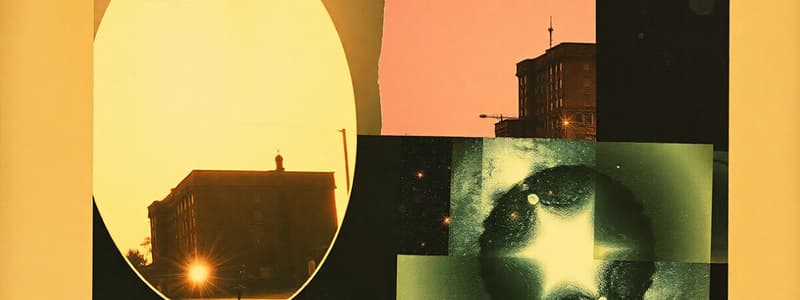Podcast
Questions and Answers
What does the law of reflection state about the angles of incidence and reflection?
What does the law of reflection state about the angles of incidence and reflection?
- The angle of incidence equals the angle of reflection. (correct)
- The angle of incidence is twice the angle of reflection.
- The angle of incidence is half of the angle of reflection.
- The angle of reflection is always greater than the angle of incidence.
Which characteristic is true for images formed by convex mirrors?
Which characteristic is true for images formed by convex mirrors?
- They can only be seen when close to the mirror.
- They are real and inverted.
- They are virtual, upright, and smaller than the object. (correct)
- They are always larger than the object.
In what way can concave mirrors produce different types of images?
In what way can concave mirrors produce different types of images?
- They can only produce virtual images regardless of distance.
- They form real or virtual images based on the object distance. (correct)
- Their images depend solely on the viewer's angle.
- They always produce real images that are smaller than the object.
What is a phenomenon caused by reflection in environments like funhouses?
What is a phenomenon caused by reflection in environments like funhouses?
Flashcards are hidden until you start studying
Study Notes
Reflections of Light
-
Law of Reflection
- States that the angle of incidence equals the angle of reflection.
- Incidence angle is measured from the normal (perpendicular to the surface).
- Applies to all types of reflective surfaces.
-
Convex Mirrors
- Curved outward, causing light rays to diverge.
- Image formed is virtual, upright, and smaller than the object.
- Widely used for safety and security (e.g., traffic mirrors, vehicle side mirrors).
-
Concave Mirrors
- Curved inward, causing light rays to converge.
- Can produce real or virtual images depending on the object distance.
- Real images formed can be inverted and magnified (e.g., used in makeup mirrors, telescopes, and headlights).
-
Optical Phenomena
- Reflection can cause various phenomena such as:
- Multiple Reflections: Occurs in environments like funhouses.
- Total Internal Reflection: Light reflects entirely within a medium, seen in optical fibers.
- Image Distortion: A result of the specific shape of mirrors affecting light paths.
- Reflection can cause various phenomena such as:
-
Applications in Technology
- Television and computer screens utilize concave mirrors for image projection.
- Convex mirrors are key in surveillance systems for enhanced field of view.
- Fiber optics rely on total internal reflection for efficient light transmission.
- Laser technologies often employ mirrors for beam direction and focus.
Law of Reflection
- The angle of incidence is equal to the angle of reflection.
- The incidence angle is measured from the normal, which is perpendicular to the reflecting surface.
- The law applies to all types of reflective surfaces.
Convex Mirrors
- Convex mirrors are curved outward.
- They cause light rays to diverge, spreading out after reflection.
- Convex mirrors create virtual, upright, and smaller images of objects.
- Common applications include traffic mirrors and vehicle side mirrors for increased visibility.
Concave Mirrors
- Concave mirrors are curved inward.
- They cause light rays to converge, focusing them at a point.
- Concave mirrors can produce both real and virtual images, depending on the object's distance.
- Real images are inverted and can be magnified, making them suitable for applications like makeup mirrors, telescopes, and headlights.
Optical Phenomena
- Multiple Reflections: Occurs when light bounces multiple times between surfaces, seen commonly in funhouses.
- Total Internal Reflection: Light is entirely reflected within a medium (e.g., optical fibers).
- Image Distortion: Specific shapes of mirrors can manipulate the path of light, causing distortion.
Applications in Technology
- Concave mirrors are used in television and computer screens to project images.
- Convex mirrors are essential in surveillance systems for wider field of view.
- Fiber optics utilize total internal reflection for efficient light transmission.
- Lasers often employ mirrors for precise beam direction and focus.
Studying That Suits You
Use AI to generate personalized quizzes and flashcards to suit your learning preferences.




